 The state of World Fisheries and Aquaculture 2006 The state of World Fisheries and Aquaculture 2006 |
Aquaculture
Aquaculture production
The contribution of aquaculture to global supplies of fish, crustaceans, molluscs and other aquatic animals3 continues to grow, increasing from 3.9 percent of total production by weight in 1970 to 27.1 percent in 2000 and 32.4 percent in 2004. Aquaculture continues to grow more rapidly than all other animal food-producing sectors. Worldwide, the sector has grown at an average rate of 8.8 percent per year since 1970, compared with only 1.2 percent for capture fisheries and 2.8 percent4 for terrestrial farmed meat production systems over the same period. Production from aquaculture has greatly outpaced population growth, with per capita supply from aquaculture increasing from 0.7 kg in 1970 to 7.1 kg in 2004, representing an average annual growth rate of 7.1 percent.
World aquaculture (food fish and aquatic plants) has grown significantly during the past half-century. From a production of below 1 million tonnes in the early 1950s, production in 2004 was reported to have risen to 59.4 million tonnes, with a value of US$70.3 billion. This represents an average annual increase of 6.9 percent in quantity and 7.7 percent in value over reported figures for 2002. In 2004, countries in the Asia and the Pacific region accounted for 91.5 percent of the production quantity and 80.5 percent of the value. Of the world total, China is reported to account for 69.6 percent of the total quantity and 51.2 percent of the total value of aquaculture production.
 |
In terms of food fish supply, the aquaculture sector in the world excluding China produced about 15 million tonnes of farmed aquatic products in 2004, compared with about 54 million tonnes from capture fisheries destined for direct human consumption. Corresponding figures reported for China were about 31 million tonnes from aquaculture and 6 million tonnes from capture fisheries – a powerful indication of the dominance of aquaculture in China.
Production within each region is diverse. In the Asia and the Pacific region, aquaculture production from China, South Asia and most of Southeast Asia consists primarily of cyprinids, while production from the rest of East Asia consists of high-value marine fish. In global terms, some 99.8 percent of cultured aquatic plants, 97.5 percent of cyprinids, 87.4 percent of penaeids and 93.4 percent of oysters come from Asia and the Pacific. Meanwhile, 55.6 percent of the world’s farmed salmonids come from Western Europe, mainly the northern part of the continent. However, carps dominate in the Central and Eastern European regions, both in quantity and in value.
In North America, channel catfish is the top aquaculture species in the United States of America, while Atlantic and Pacific salmon dominate in Canada. In Latin America and the Caribbean, over the past decade, salmonids have overtaken shrimp as the top aquaculture species group following disease outbreaks in major shrimp-producing areas and rapid growth in salmon production in Chile.
The sub-Saharan Africa region continues to be a minor player in aquaculture despite its natural potential. Even aquaculture of tilapia, which is native to the continent, has not developed significantly. Nigeria leads in the region, with reported production of 44 000 tonnes of catfish, tilapia and other freshwater fishes. There are some encouraging signs in the continent: black tiger shrimp (Penaeus monodon) in Madagascar and Eucheuma seaweed in the United Republic of Tanzania are thriving, and production of niche species such as abalone (Haliotis spp.) in South Africa is increasing. In the Near East and North Africa, Egypt is by far the dominant country in terms of production (providing 92 percent of the regional total) and is now the second biggest tilapia producer after China and the world’s top producer of mullets.
The top ten producing countries for food fish supply from aquaculture in 2004 are indicated in Table 4 along with the top ten countries in terms of annual growth in aquaculture production for the two-year period 2002−04. All regions showed increases in production from 2002 to 2004, led by the Near East and North Africa region and Latin America and the Caribbean with 13.5 and 9.6 percent average annual growth, respectively.
World aquatic plant production in 2004 reached 13.9 million tonnes (US$6.8 billion), of which 10.7 million tonnes (US$5.1 billion) originated from China, 1.2 million tonnes from the Philippines, 0.55 million tonnes from the Republic of Korea and 0.48 million tonnes from Japan. Japanese kelp (Laminaria japonica – 4.5 million tonnes) showed the highest production followed by Wakame (Undaria pinnatifida – 2.5 million tonnes) and Nori (Porphya tenera – 1.3 million tonnes). An additional 2.6 million tonnes were reported by countries as “aquatic plants” and not further specified. The production of aquatic plants increased rapidly from the 2002 total of 11.6 million tonnes, primarily as a result of large production increases in China.
The growth in production of the different major species groups continues, although the increases seen so far this decade are less dramatic than the extraordinary growth rates achieved in the 1980s and 1990s (Figure 11, Table 5). The period 2000−04 has seen strong growth in production of crustaceans, in particular, and of marine fish. Growth rates for the production of the other species groups have begun to slow and the overall rate of growth, while still substantial, is not comparable with the significant rate increases seen in the previous two decades. Thus, while the trend for the near future appears to be one of continued increases in production, the rate of these increases may be moderating. Figure 12 presents an overview of aquaculture production in terms of quantity and value by major species group for 2004.
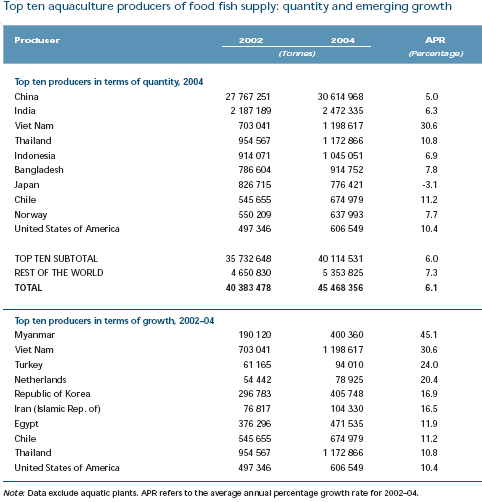 |
The top ten species groups in terms of production quantity and percentage increase in production quantity from 2002 to 2004 are shown in Table 6. Production of carps far exceeded that for all other species groups, accounting for over 40 percent (18.3 million tonnes) of total production of fish, crustaceans and molluscs in 2004. Combined, the top ten species groups account for 90.5 percent of the total aquaculture contribution to fisheries food supply. The largest production for an individual species was the Pacific cupped oyster (Crassostrea gigas – 4.4 million tonnes), followed by three species of carp – the silver carp (Hypophthalmichthys molitrix – 4.0 million tonnes), the grass carp (Ctenopharyngodon idellus – 3.9 million tonnes) and the common carp (Cyprinus carpio – 3.4 million tonnes). In terms of value, shrimp culture is second in importance and has increased substantially in the 2002−04 period.
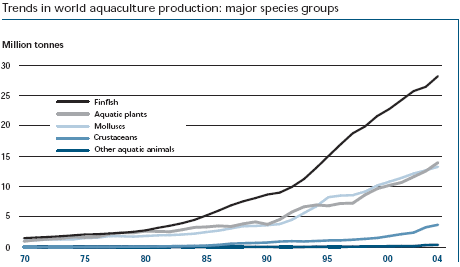
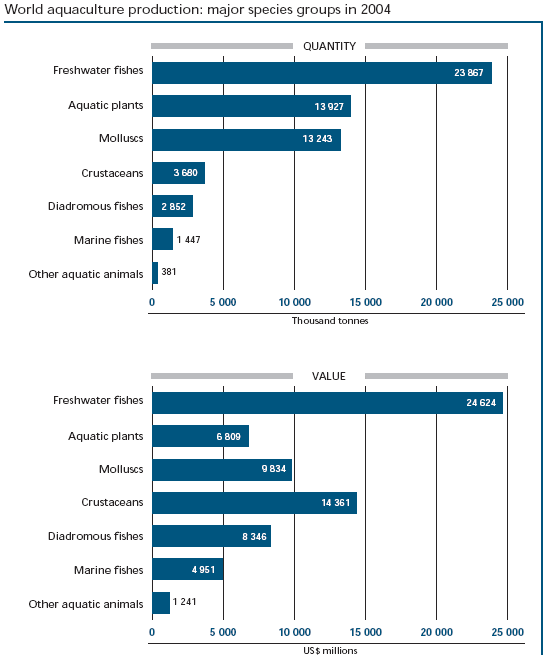
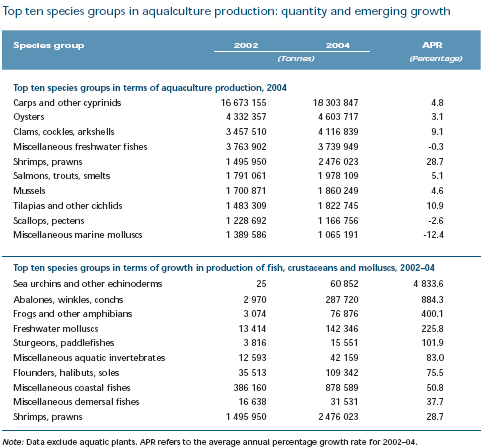
The increasing diversity of aquaculture production can be seen in the list of species groups registering the largest growth from 2002 to 2004. Sea urchins and other echinoderms lead the list with a remarkable increase in reported production from 25 tonnes in 2002 to 60 852 tonnes in 2004. In reality, while this does represent an area of emerging activity in aquaculture, this item also reflects an effort made by China to improve its reporting of aquaculture data. Beginning in 2003, China greatly expanded the number of species reported in its data, including 15 new freshwater species and 13 new marine species. This resulted in corresponding decreases in the reporting of production in aggregated, “unspecified” groupings.
Most aquaculture production of fish, crustaceans and molluscs continues to derive from the freshwater environment (56.6 percent by quantity and 50.1 percent by value) (Figure 13). Mariculture contributes 36.0 percent of production quantity and 33.6 percent of the total value. While much of the marine production consists of high-value finfish, there is also a large amount of relatively low-priced mussels and oysters.7 Although brackish-water production represented only 7.4 percent of production quantity in 2004, it contributed 16.3 percent of the total value, reflecting the prominence of high-value crustaceans and finfish.
From 1970 to 2004, Chinese inland water aquaculture production increased at an average annual rate of 10.8 percent, compared with 7.0 percent in the rest of the world. Similarly, during the same period, Chinese aquaculture production in marine areas, excluding aquatic plants, increased at an average annual rate of 10.7 percent compared with 5.9 percent in the rest of the world. Figure 14 shows trends in inland and marine aquaculture production for China and the rest of the world.
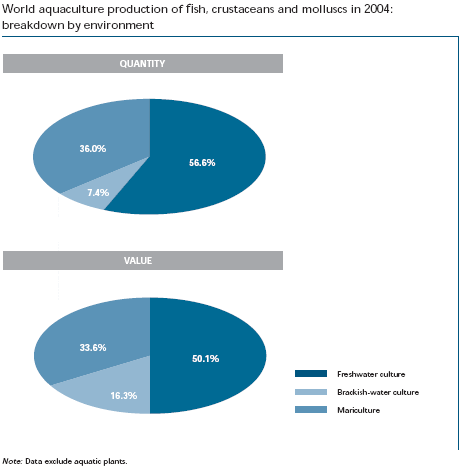
Unlike terrestrial farming systems, where the bulk of global production is based on a limited number of animal and plant species, over 240 different farmed aquatic animal and plant species were reported in 2004, an increase of 20 species compared with the number reported in 2002. These 240 species represent 94 families; moreover, this diversity is probably underestimated, as 8.9 million tonnes (15.1 percent) of global aquaculture production, including an additional 20 families, was not reported to the species level in 2004, and this “unspecified” group is likely to include species not yet recorded as being cultured. Of aquaculture reported to FAO to the species level, the top ten species account for 61.7 percent of total production and the top 25 species for 86.6 percent. These figures are lower than those for 2000 (68.1 percent and 91.0 percent, respectively), providing a further indication that species diversification in aquaculture is increasing.
It is noteworthy that the growth of aquaculture production of fish, crustaceans and molluscs within developing countries has exceeded the corresponding growth in developed countries, proceeding at an average annual rate of 10.2 percent since 1970. In contrast, aquaculture production within developed countries has been increasing at an average rate of 3.9 percent per year. In developing countries other than China, production has grown at an annual rate of 8.2 percent. In 1970, developing countries accounted for 58.8 percent of production, while in 2002 their share was 91.4 percent. In the period from 2002 to 2004, the trend was even more dramatic as production in developing countries other than China increased at an annual rate of 11.0 percent, compared with 5.0 percent for China and 2.3 percent for developed countries.
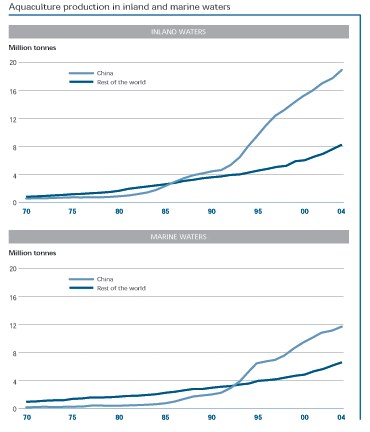
With the exception of marine shrimp, the bulk of aquaculture production within developing countries in 2004 comprised omnivorous/herbivorous fish or filter-feeding species. In contrast, approximately three-quarters of finfish culture production in developed countries was of carnivorous species.
Further Information
To view further articles from The State of World Fisheries and Aquaculture 2006, please click here
March 2007

